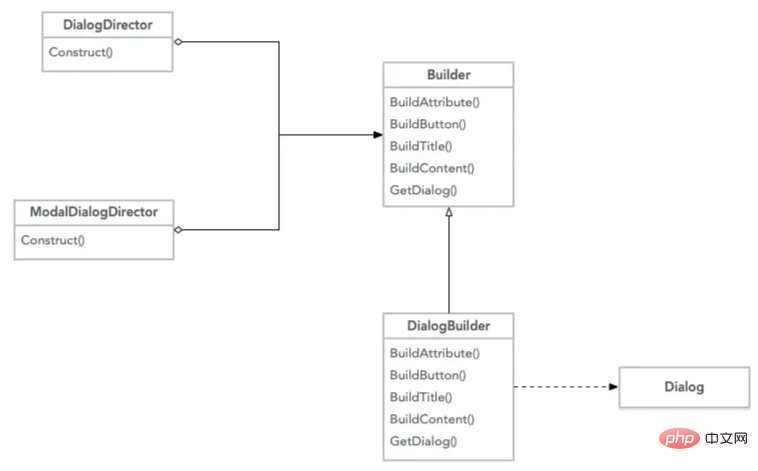
In the previous article " A brief discussion of the intermediary pattern in PHP" we introduced the intermediary pattern in PHP. The following article will take you to understand the builder pattern in the PHP design pattern. .

Builder mode can also be called generator mode. The original meaning of the word builder includes the meaning of builder, developer and creator. Obviously, this mode is another creation mode, used to create objects. So what are its characteristics? From an architectural point of view, building a house is not something that can be built immediately, but is built brick by brick. A house not only has bricks and tiles, but also various pipes, various wires, etc., and their various parts together form a house. It can be said that the builder pattern is a very vivid process of composing an object (house) from various components.
GoF definition: Separate the construction of a complex object from its representation, so that the same construction process can create different representations
GoF Class Diagram

Code Implementation
class Product
{
private $parts = [];
public function Add(String $part): void
{
$this->parts[] = $part;
}
public function Show(): void
{
echo PHP_EOL . '产品创建 ----', PHP_EOL;
foreach ($this->parts as $part) {
echo $part, PHP_EOL;
}
}
}Product class, you can put it Think of it as the house we want to build. The house at this time has no content, we need to add bricks and tiles to it.
interface Builder
{
public function BuildPartA(): void;
public function BuildPartB(): void;
public function GetResult(): Product;
}
class ConcreteBuilder1 implements Builder
{
private $product;
public function __construct()
{
$this->product = new Product();
}
public function BuildPartA(): void
{
$this->product->Add('部件A');
}
public function BuildPartB(): void
{
$this->product->Add('部件B');
}
public function GetResult(): Product
{
return $this->product;
}
}
class ConcreteBuilder2 implements Builder
{
private $product;
public function __construct()
{
$this->product = new Product();
}
public function BuildPartA(): void
{
$this->product->Add('部件X');
}
public function BuildPartB(): void
{
$this->product->Add('部件Y');
}
public function GetResult(): Product
{
return $this->product;
}
}Builder abstraction and its implementation. Different developers will always use different brands of materials. Here we have two different developers, but their purpose is the same, to build a house (Product).
class Director
{
public function Construct(Builder $builder)
{
$builder->BuildPartA();
$builder->BuildPartB();
}
}Constructor, used to call the builder for production. That's right, it's our engineering team. It selects materials and builds. The same engineering team can take on different orders, but all they build are houses. Only the materials and appearance of this house are different, but the general craftsmanship is still the same.
$director = new Director(); $b1 = new ConcreteBuilder1(); $b2 = new ConcreteBuilder2(); $director->Construct($b1); $p1 = $b1->getResult(); $p1->Show(); $director->Construct($b2); $p2 = $b2->getResult(); $p2->Show();
Finally, let’s take a look at our implementation. Is it very simple? Just prepare the engineering team, prepare different builders, and then hand it over to the engineering team for production! !
As we all know, mobile phone assembly is a complicated process, so we have corresponding models of mobile phones The drawings (Builder) are handed over to the workers (Director) on the assembly line, and they will use the accessories according to the drawings to produce the various models of mobile phones (Product) we need. It's obvious that we are all great builders, adding to our industry! ! !
Full code: https://github.com/zhangyue0503/designpatterns-php/blob/master/16.builder/source/builder.php
As mentioned before, many Dialog dialog boxes in Android are implemented using the builder mode. As the owner of a mobile phone factory, customized Android system is also a very important part. Just like the X Mi, we started with MIUI and won the software market first, making everyone feel that this system is very easy to use, and then started developing mobile phones. This shows that software and hardware are indeed the two most important components of modern mobile phones, and neither one can survive without them. This time, we will use the builder mode to simply implement a set of dialog components!
Dialog class diagram

Full source code: https://github.com/zhangyue0503/designpatterns-php /blob/master/16.builder/source/builder-dialog.php
<?php
class Dialog
{
private $attributes = [];
private $buttons = [];
private $title = '';
private $content = '';
public function AddAttributes($attr)
{
$this->attributes[] = $attr;
}
public function AddButtons($button)
{
$this->buttons[] = $button;
}
public function SetTitle($title)
{
$this->title = $title;
}
public function SetContent($content)
{
$this->content = $content;
}
public function ShowDialog(){
echo PHP_EOL, '显示提示框 === ', PHP_EOL;
echo '标题:' . $this->title, PHP_EOL;
echo '内容:' . $this->content, PHP_EOL;
echo '样式:' . implode(',', $this->attributes), PHP_EOL;
echo '按扭:' . implode(',', $this->buttons), PHP_EOL;
}
}
interface Builder
{
public function BuildAttribute($attr);
public function BuildButton($button);
public function BuildTitle($title);
public function BuildContent($content);
public function GetDialog();
}
class DialogBuilder implements Builder{
private $dialog;
public function __construct(){
$this->dialog = new Dialog();
}
public function BuildAttribute($attr){
$this->dialog->AddAttributes($attr);
}
public function BuildButton($button){
$this->dialog->AddButtons($button);
}
public function BuildTitle($title){
$this->dialog->SetTitle($title);
}
public function BuildContent($content){
$this->dialog->SetContent($content);
}
public function GetDialog(){
return $this->dialog;
}
}
class DialogDirector {
public function Construct($title, $content){
$builder = new DialogBuilder();
$builder->BuildAttribute('置于顶层');
$builder->BuildAttribute('居中显示');
$builder->BuildButton('确认');
$builder->BuildButton('取消');
$builder->BuildTitle($title);
$builder->BuildContent($content);
return $builder;
}
}
class ModalDialogDirector {
public function Construct($title, $content){
$builder = new DialogBuilder();
$builder->BuildAttribute('置于顶层');
$builder->BuildAttribute('居中显示');
$builder->BuildAttribute('背景庶照');
$builder->BuildAttribute('外部无法点击');
$builder->BuildButton('确认');
$builder->BuildButton('取消');
$builder->BuildTitle($title);
$builder->BuildContent($content);
return $builder;
}
}
$d1 = new DialogDirector();
$d1->Construct('窗口1', '确认要执行操作A吗?')->GetDialog()->ShowDialog();
$d2 = new ModalDialogDirector();
$d2->Construct('窗口2', '确认要执行操作B吗?')->GetDialog()->ShowDialog();Description
Original address: https://juejin.cn/post/6844903981836320781
Author: Hardcore Project Manager
Recommended learning: "PHP Video tutorial》
The above is the detailed content of An in-depth analysis of the builder pattern in PHP. For more information, please follow other related articles on the PHP Chinese website!